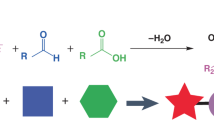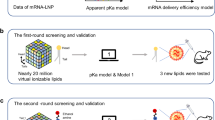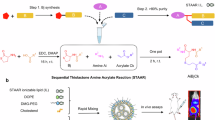Abstract
Ionizable lipids are a key component of lipid nanoparticles, the leading nonviral messenger RNA delivery technology. Here, to advance the identification of ionizable lipids beyond current methods, which rely on experimental screening and/or rational design, we introduce lipid optimization using neural networks, a deep-learning strategy for ionizable lipid design. We created a dataset of >9,000 lipid nanoparticle activity measurements and used it to train a directed message-passing neural network for prediction of nucleic acid delivery with diverse lipid structures. Lipid optimization using neural networks predicted RNA delivery in vitro and in vivo and extrapolated to structures divergent from the training set. We evaluated 1.6 million lipids in silico and identified two structures, FO-32 and FO-35, with local mRNA delivery to the mouse muscle and nasal mucosa. FO-32 matched the state of the art for nebulized mRNA delivery to the mouse lung, and both FO-32 and FO-35 efficiently delivered mRNA to ferret lungs. Overall, this work shows the utility of deep learning for improving nanoparticle delivery.
This is a preview of subscription content, access via your institution
Access options
Access Nature and 54 other Nature Portfolio journals
Get Nature+, our best-value online-access subscription
$32.99 / 30 days
cancel any time
Subscribe to this journal
Receive 12 print issues and online access
$259.00 per year
only $21.58 per issue
Buy this article
- Purchase on SpringerLink
- Instant access to full article PDF
Prices may be subject to local taxes which are calculated during checkout





Similar content being viewed by others
Data availability
All code and data used for training models can be found at GitHub via https://github.com/jswitten/LNP_ML (ref. 63). Source data are provided with this paper.
Code availability
All code and data used for training models can be found at GitHub via https://github.com/jswitten/LNP_ML (ref. 63).
References
Hou, X., Zaks, T., Langer, R. & Dong, Y. Lipid nanoparticles for mRNA delivery. Nat. Rev. Mater. 6, 1078–1094 (2021).
Barbier, A. J., Jiang, A. Y., Zhang, P., Wooster, R. & Anderson, D. G. The clinical progress of mRNA vaccines and immunotherapies. Nat. Biotechnol. 40, 840–854 (2022).
Witten, J., Hu, Y., Langer, R. & Anderson, D. G. Recent advances in nanoparticulate RNA delivery systems. Proc. Natl Acad. Sci. USA 121, e2307798120 (2024).
Polack, F. P. et al. Safety and efficacy of the BNT162b2 mRNA COVID-19 vaccine. N. Engl. J. Med. 383, 2603–2615 (2020).
Baden, L. R. et al. Efficacy and safety of the mRNA-1273 SARS-CoV-2 vaccine. N. Engl. J. Med. 384, 403–416 (2021).
Gillmore, J. D. et al. CRISPR–Cas9 in vivo gene editing for transthyretin amyloidosis. N. Engl. J. Med. 385, 493–502 (2021).
Rothgangl, T. et al. In vivo adenine base editing of PCSK9 in macaques reduces LDL cholesterol levels. Nat. Biotechnol. 39, 949–957 (2021).
Heymans, S. & Cooper, L. T. Myocarditis after COVID-19 mRNA vaccination: clinical observations and potential mechanisms. Nat. Rev. Cardiol. 19, 75–77 (2022).
vander Straeten, A. et al. A microneedle vaccine printer for thermostable COVID-19 mRNA vaccines. Nat. Biotechnol. 42, 510–517 (2024).
Muramatsu, H. et al. Lyophilization provides long-term stability for a lipid nanoparticle-formulated, nucleoside-modified mRNA vaccine. Mol. Ther. 30, 1941–1951 (2022).
Loughrey, D. & Dahlman, J. E. Non-liver mRNA delivery. Acc. Chem. Res. 55, 13–23 (2022).
Hodges, C. A. & Conlon, R. A. Delivering on the promise of gene editing for cystic fibrosis. Genes Dis. 6, 97–108 (2018).
Ensinck, M., Mottais, A., Detry, C., Leal, T. & Carlon, M. S. On the corner of models and cure: gene editing in cystic fibrosis. Front. Pharmacol. 12, 662110 (2021).
Choi, S. H. & Engelhardt, J. F. Gene therapy for cystic fibrosis: lessons learned and paths forward. Mol. Ther. 29, 428–430 (2021).
Miao, L. et al. Delivery of mRNA vaccines with heterocyclic lipids increases anti-tumor efficacy by STING-mediated immune cell activation. Nat. Biotechnol. 37, 1174–1185 (2019).
Ruigrok, M. J. R., Frijlink, H. W., Melgert, B. N., Olinga, P. & Hinrichs, W. L. J. Gene therapy strategies for idiopathic pulmonary fibrosis: recent advances, current challenges, and future directions. Mol. Ther. Methods Clin. Dev. 20, 483–496 (2021).
Bai, X. et al. Inhaled siRNA nanoparticles targeting IL11 inhibit lung fibrosis and improve pulmonary function post-bleomycin challenge. Sci. Adv. 8, eabn7162 (2022).
Zhang, R. et al. Inhaled mRNA nanoformulation with biogenic ribosomal protein reverses established pulmonary fibrosis in a bleomycin-induced murine model. Adv. Mater. 34, e2107506 (2022).
Guan, S., Darmstädter, M., Xu, C. & Rosenecker, J. In vitro investigations on optimizing and nebulization of IVT-mRNA formulations for potential pulmonary-based alpha-1-antitrypsin deficiency treatment. Pharmaceutics 13, 1281 (2021).
Wu, D.-D. et al. The potential for targeted rewriting of epigenetic marks in COPD as a new therapeutic approach. Pharmacol. Ther. 182, 1–14 (2018).
Woo, C. J. et al. Inhaled delivery of a lipid nanoparticle encapsulated messenger RNA encoding a ciliary protein for the treatment of primary ciliary dyskinesia. Pulm. Pharmacol. Ther. 75, 102134 (2022).
da Silva, A. L. et al. Nanoparticle-based thymulin gene therapy therapeutically reverses key pathology of experimental allergic asthma. Sci. Adv. 6, eaay7973 (2020).
Zeyer, F. et al. mRNA-mediated gene supplementation of Toll-like receptors as treatment strategy for asthma in vivo. PLoS ONE 11, e0154001 (2016).
Sabnis, S. et al. A novel amino lipid series for mRNA delivery: improved endosomal escape and sustained pharmacology and safety in non-human primates. Mol. Ther. 26, 1509–1519 (2018).
Hashiba, K. et al. Branching ionizable lipids can enhance the stability, fusogenicity, and functional delivery of mRNA. Small Sci. 3, 2370001 (2023).
Lam, K. et al. Unsaturated, trialkyl ionizable lipids are versatile LNP components for therapeutic and vaccine applications. Adv. Mater. 35, 2209624 (2023).
Whitehead, K. A. et al. Degradable lipid nanoparticles with predictable in vivo siRNA delivery activity. Nat. Commun. 5, 4277 (2014).
Li, B. et al. Accelerating ionizable lipid discovery for mRNA delivery using machine learning and combinatorial chemistry. Nat. Mater. 23, 1002–1008 (2024).
Stokes, J. M. et al. A deep learning approach to antibiotic discovery. Cell 180, 688–702.e13 (2020).
Yang, K. et al. Analyzing learned molecular representations for property prediction. J. Chem. Inf. Model. 59, 3370–3388 (2019).
Soleimany, A. P. et al. Evidential deep learning for guided molecular property prediction and discovery. ACS Cent. Sci. 7, 1356–1367 (2021).
Reker, D. et al. Computationally guided high-throughput design of self-assembling drug nanoparticles. Nat. Nanotechnol. 16, 725–733 (2021).
Liu, G. et al. Deep learning-guided discovery of an antibiotic targeting Acinetobacter baumannii. Nat. Chem. Biol. 19, 1342–1350 (2023).
Wong, F. et al. Discovery of a structural class of antibiotics with explainable deep learning. Nature 626, 177–185 (2024).
Rhym, L. H., Manan, R. S., Koller, A., Stephanie, G. & Anderson, D. G. Peptide-encoding mRNA barcodes for the high-throughput in vivo screening of libraries of lipid nanoparticles for mRNA delivery. Nat. Biomed. Eng. 7, 901–910 (2023).
Ryan, K. A. et al. Dose-dependent response to infection with SARS-CoV-2 in the ferret model and evidence of protective immunity. Nat. Commun. 12, 81 (2021).
Rosen, B. H. et al. Animal and model systems for studying cystic fibrosis. J. Cyst. Fibros. 17, S28–S34 (2018).
Yuan, F. et al. Transgenic ferret models define pulmonary ionocyte diversity and function. Nature 621, 857–867 (2023).
Rotolo, L. et al. Species-agnostic polymeric formulations for inhalable messenger RNA delivery to the lung. Nat. Mater. 22, 369–379 (2023).
Boucher, R. C. Muco-obstructive lung diseases. N. Engl. J. Med. 380, 1941–1953 (2019).
Li, B. et al. Enhancing the immunogenicity of lipid-nanoparticle mRNA vaccines by adjuvanting the ionizable lipid and the mRNA. Nat. Biomed. Eng. https://doi.org/10.1038/s41551-023-01082-6 (2023).
Jiang, A. Y. et al. Combinatorial development of nebulized mRNA delivery formulations for the lungs. Nat. Nanotechnol. 19, 364–375 (2024).
Miller, J. B. et al. Non-viral CRISPR/Cas gene editing in vitro and in vivo enabled by synthetic nanoparticle co-delivery of Cas9 mRNA and sgRNA. Angew. Chem. Int. Ed. 56, 1059–1063 (2017).
Zhou, K. et al. Modular degradable dendrimers enable small RNAs to extend survival in an aggressive liver cancer model. Proc. Natl Acad. Sci. USA 113, 520–525 (2016).
Liu, S. et al. Membrane-destabilizing ionizable phospholipids for organ-selective mRNA delivery and CRISPR–Cas gene editing. Nat. Mater. 20, 701–710 (2021).
Li, B. et al. Combinatorial design of nanoparticles for pulmonary mRNA delivery and genome editing. Nat. Biotechnol. 41, 1410–1415 (2023).
Akinc, A. et al. A combinatorial library of lipid-like materials for delivery of RNAi therapeutics. Nat. Biotechnol. 26, 561–569 (2008).
Lee, S. M. et al. A systematic study of unsaturation in lipid nanoparticles leads to improved mRNA transfection in vivo. Angew. Chem. 133, 5912–5917 (2021).
Li, L. et al. A biomimetic lipid library for gene delivery through thiol-yne click chemistry. Biomaterials 33, 8160–8166 (2012).
Heid, E. et al. Chemprop: a machine learning package for chemical property prediction. J. Chem. Inf. Model. 64, 9–17 (2024).
Wu, Z. et al. MoleculeNet: a benchmark for molecular machine learning. Chem. Sci. 9, 513–530 (2018).
He, Z. et al. A multidimensional approach to modulating ionizable lipids for high-performing and organ-selective mRNA delivery. Angew. Chem. Int. Ed. 62, e202310401 (2023).
Kauffman, K. J. et al. Optimization of lipid nanoparticle formulations for mRNA delivery in vivo with fractional factorial and definitive screening designs. Nano Lett. 15, 7300–7306 (2015).
Gilleron, J. et al. Image-based analysis of lipid nanoparticle-mediated siRNA delivery, intracellular trafficking and endosomal escape. Nat. Biotechnol. 31, 638–646 (2013).
Carrasco, M. J. et al. Ionization and structural properties of mRNA lipid nanoparticles influence expression in intramuscular and intravascular administration. Commun. Biol. 4, 956 (2021).
Fischer, A. J. et al. Mucus strands from submucosal glands initiate mucociliary transport of large particles. JCI Insight 4, e124863 (2019).
Ostedgaard, L. S. et al. Lack of airway submucosal glands impairs respiratory host defenses. eLife 9, e59653 (2020).
Tata, P. R. & Rajagopal, J. Plasticity in the lung: making and breaking cell identity. Development 144, 755–766 (2017).
Plasschaert, L. W. et al. A single-cell atlas of the airway epithelium reveals the CFTR-rich pulmonary ionocyte. Nature 560, 377–381 (2018).
Shah, V. S., Chivukula, R. R., Lin, B., Waghray, A. & Rajagopal, J. Cystic fibrosis and the cells of the airway epithelium: what are ionocytes and what do they do? Annu. Rev. Pathol. Mech. Dis. 17, 23–46 (2022).
Bajusz, D., Rácz, A. & Héberger, K. Why is Tanimoto index an appropriate choice for fingerprint-based similarity calculations? J. Cheminform. 7, 20 (2015).
Miao, L. et al. Synergistic lipid compositions for albumin receptor mediated delivery of mRNA to the liver. Nat. Commun. 11, 2424 (2020).
Witten, J. & Collins, E. LNP ML. GitHub https://github.com/jswitten/LNP_ML (2024).
Guo, Z. et al. Diffusion models in bioinformatics and computational biology. Nat. Rev. Bioeng. 2, 136–154 (2024).
Reverberi, C. et al. Experimental evidence of effective human–AI collaboration in medical decision-making. Sci. Rep. 12, 14952 (2022).
Xu, Y., Golubovic, A., Xu, S., Pan, A. & Li, B. Rational design and combinatorial chemistry of ionizable lipids for RNA delivery. J. Mater. Chem. B 11, 6527–6539 (2023).
Du, S. et al. Cholesterol-amino-phosphate (CAP) derived lipid nanoparticles for delivery of self-amplifying RNA and restoration of spermatogenesis in infertile mice. Adv. Sci. 10, 2300188 (2023).
Andries, O. et al. Comparison of the gene transfer efficiency of mRNA/GL67 and pDNA/GL67 complexes in respiratory cells. Mol. Pharm. 9, 2136–2145 (2012).
Hou, X. et al. Vitamin lipid nanoparticles enable adoptive macrophage transfer for the treatment of multidrug-resistant bacterial sepsis. Nat. Nanotechnol. 15, 41–46 (2020).
Oyama, R. et al. An ionizable lipid material with a vitamin E scaffold as an mRNA vaccine platform for efficient cytotoxic T cell responses. ACS Nano 17, 18758–18774 (2023).
Goldman, R. L. et al. Understanding structure activity relationships of good HEPES lipids for lipid nanoparticle mRNA vaccine applications. Biomaterials 301, 122243 (2023).
Yan, Z., McCray, P. B. Jr & Engelhardt, J. F. Advances in gene therapy for cystic fibrosis lung disease. Hum. Mol. Genet. 28, R88–R94 (2019).
Lee, J.-A. et al. Gene therapy for cystic fibrosis: new tools for precision medicine. J. Transl. Med. 19, 452 (2021).
Boucher, R. C. Status of gene therapy for cystic fibrosis lung disease. J. Clin. Invest. 103, 441–445 (1999).
Ulrich, M. et al. Alveolar inflammation in cystic fibrosis. J. Cyst. Fibros. 9, 217–227 (2010).
Lin, C.-R., Bahmed, K. & Kosmider, B. Impaired alveolar re-epithelialization in pulmonary emphysema. Cells 11, 2055 (2022).
Chen, D. et al. Rapid discovery of potent siRNA-containing lipid nanoparticles enabled by controlled microfluidic formulation. J. Am. Chem. Soc. 134, 6948–6951 (2012).
Ferguson, L. T. et al. Mechanisms by which liposomes improve inhaled drug delivery for alveolar diseases. Adv. NanoBiomed Res. 3, 2200106 (2023).
Yu, M. et al. Highly efficient transgenesis in ferrets using CRISPR/Cas9-mediated homology-independent insertion at the ROSA26 locus. Sci. Rep. 9, 1971 (2019).
Tang, Y. et al. Repeat dosing of AAV2.5T to ferret lungs elicits an antibody response that diminishes transduction in an age-dependent manner. Mol. Ther. Methods Clin. Dev. 19, 186–200 (2020).
Tang, Y. et al. Immunosuppression reduces rAAV2.5T neutralizing antibodies that limit efficacy following repeat dosing to ferret lungs. Mol. Ther. Methods Clin. Dev. 29, 70–80 (2023).
Acknowledgements
This work was supported by Sanofi and the National Institutes of Health (grant no. HL162564-02 and R61AI161805 to D.G.A. and grants no. HL152960, DK054759 and 75N92019C00010 to J.F.E.). It was also funded in part by a grant from the Alpha-1 Foundation. J.W. was supported by the Cystic Fibrosis Foundation awards WITTEN19XX0 and 004831F5222 and the Convergence Scholars Program through the Marble Center for Cancer Nanomedicine. This work was supported in part by the Koch Institute support grant 5P30-CA14051 from the National Cancer Institute. We thank the Koch Institute’s Robert A. Swanson (1969) Biotechnology Center for technical support, specifically the Animal Imaging and Preclinical Testing, Flow Cytometry, and Peterson (1957) Nanotechnology Materials core facilities.
Author information
Authors and Affiliations
Contributions
J.W., I.R., R.S.M., E.B., S.B., Y.T., M.E., J.L., D.N., F.O., A.Y.J., E.M., Y.H., H.M., A.S., E.C., Z.Y. and J.F.E. performed experiments and analyzed data. J.W., R.L. and D.G.A. discussed the results and wrote the paper with input from all authors. R.L. and D.G.A. acquired funding and supervised the project. J.W., I.R. and R.S.M. contributed equally and all reserve the right to list themselves first on their curricula vitae (CVs).
Corresponding author
Ethics declarations
Competing interests
J.W., I.R. and D.G.A. have filed a patent for the 4CR ketone biodegradable lipid library described herein and J.W., R.S.M. and D.G.A. have filed a patent for the branched-ester library described herein. Z.Y. and J.F.E. are consultants for Spirovant Sciences. D.G.A. receives research funding from Sanofi/Translate Bio and is a Founder of oRNA Tx. R.L. is a co-founder and board of director of Moderna. He also serves on the board and has equity in Particles For Humanity. For a list of entities with which R.L. is, or has been recently involved compensated or uncompensated, see https://www.dropbox.com/s/yc3xqb5s8s94v7x/Rev%20Langer%20COI.pdf?dl=0. The other authors declare no competing interests.
Peer review
Peer review information
Nature Biotechnology thanks Yizhou Dong, Ho Lun Wong and the other, anonymous, reviewer(s) for their contribution to the peer review of this work.
Additional information
Publisher’s note Springer Nature remains neutral with regard to jurisdictional claims in published maps and institutional affiliations.
Supplementary information
Supplementary Information
Supplementary Figs. 1–28, Tables 1–7 and lipid synthesis protocols.
Supplementary Data 1
Source data for Supplementary Information.
Source data
Source Data Figs. 1–4
Statistical source data for Figs. 1–4.
Rights and permissions
Springer Nature or its licensor (e.g. a society or other partner) holds exclusive rights to this article under a publishing agreement with the author(s) or other rightsholder(s); author self-archiving of the accepted manuscript version of this article is solely governed by the terms of such publishing agreement and applicable law.
About this article
Cite this article
Witten, J., Raji, I., Manan, R.S. et al. Artificial intelligence-guided design of lipid nanoparticles for pulmonary gene therapy. Nat Biotechnol (2024). https://doi.org/10.1038/s41587-024-02490-y
Received:
Accepted:
Published:
DOI: https://doi.org/10.1038/s41587-024-02490-y
This article is cited by
-
Progress of personalized medicine of cystic fibrosis in the times of efficient CFTR modulators
Molecular and Cellular Pediatrics (2025)
-
Machine learning techniques for lipid nanoparticle formulation
Nano Convergence (2025)
-
Protein lipidation in the tumor microenvironment: enzymology, signaling pathways, and therapeutics
Molecular Cancer (2025)
-
Nano-formulations in disease therapy: designs, advances, challenges, and future directions
Journal of Nanobiotechnology (2025)
-
Research progress of mRNA vaccines for infectious diseases
European Journal of Medical Research (2025)



